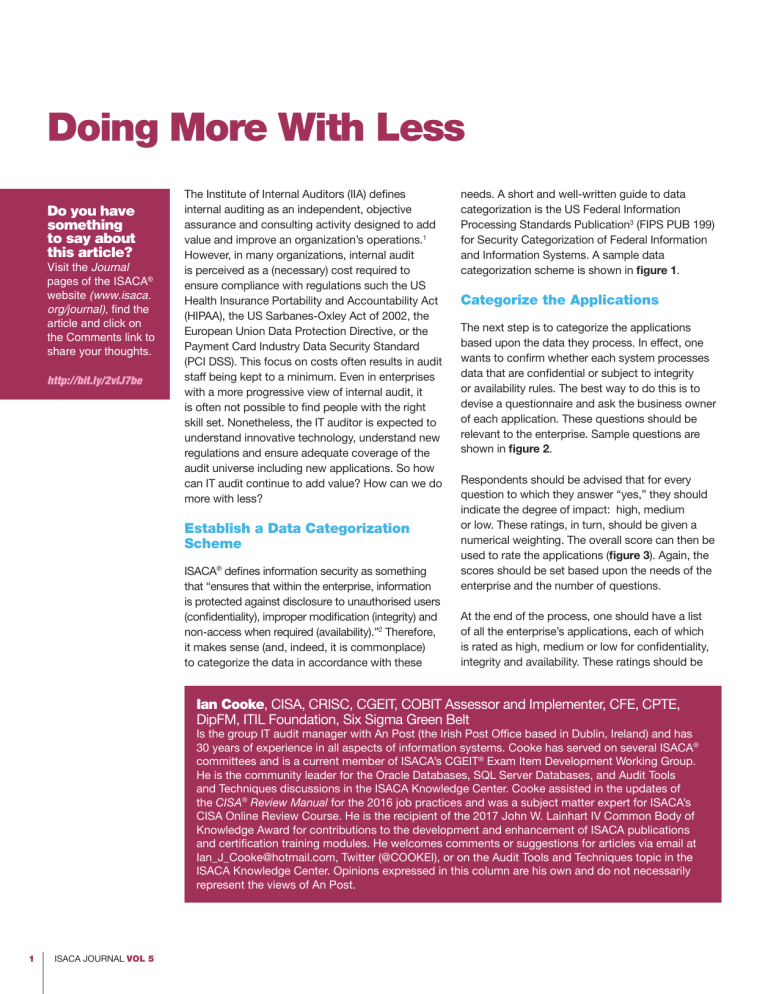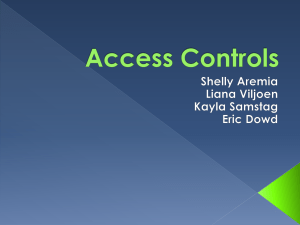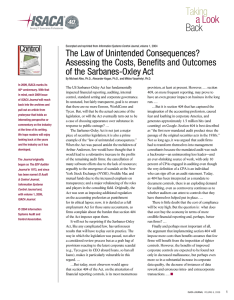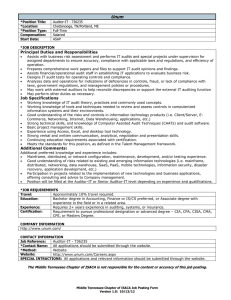
Doing More With Less Do you have something to say about this article? Visit the Journal pages of the ISACA® website (www.isaca. org/journal), find the article and click on the Comments link to share your thoughts. http://bit.ly/2vlJ7be The Institute of Internal Auditors (IIA) defines internal auditing as an independent, objective assurance and consulting activity designed to add value and improve an organization’s operations.1 However, in many organizations, internal audit is perceived as a (necessary) cost required to ensure compliance with regulations such the US Health Insurance Portability and Accountability Act (HIPAA), the US Sarbanes-Oxley Act of 2002, the European Union Data Protection Directive, or the Payment Card Industry Data Security Standard (PCI DSS). This focus on costs often results in audit staff being kept to a minimum. Even in enterprises with a more progressive view of internal audit, it is often not possible to find people with the right skill set. Nonetheless, the IT auditor is expected to understand innovative technology, understand new regulations and ensure adequate coverage of the audit universe including new applications. So how can IT audit continue to add value? How can we do more with less? Establish a Data Categorization Scheme ISACA® defines information security as something that “ensures that within the enterprise, information is protected against disclosure to unauthorised users (confidentiality), improper modification (integrity) and non-access when required (availability).”2 Therefore, it makes sense (and, indeed, it is commonplace) to categorize the data in accordance with these needs. A short and well-written guide to data categorization is the US Federal Information Processing Standards Publication3 (FIPS PUB 199) for Security Categorization of Federal Information and Information Systems. A sample data categorization scheme is shown in figure 1. Categorize the Applications The next step is to categorize the applications based upon the data they process. In effect, one wants to confirm whether each system processes data that are confidential or subject to integrity or availability rules. The best way to do this is to devise a questionnaire and ask the business owner of each application. These questions should be relevant to the enterprise. Sample questions are shown in figure 2. Respondents should be advised that for every question to which they answer “yes,” they should indicate the degree of impact: high, medium or low. These ratings, in turn, should be given a numerical weighting. The overall score can then be used to rate the applications (figure 3). Again, the scores should be set based upon the needs of the enterprise and the number of questions. At the end of the process, one should have a list of all the enterprise’s applications, each of which is rated as high, medium or low for confidentiality, integrity and availability. These ratings should be Ian Cooke, CISA, CRISC, CGEIT, COBIT Assessor and Implementer, CFE, CPTE, DipFM, ITIL Foundation, Six Sigma Green Belt Is the group IT audit manager with An Post (the Irish Post Office based in Dublin, Ireland) and has 30 years of experience in all aspects of information systems. Cooke has served on several ISACA® committees and is a current member of ISACA’s CGEIT® Exam Item Development Working Group. He is the community leader for the Oracle Databases, SQL Server Databases, and Audit Tools and Techniques discussions in the ISACA Knowledge Center. Cooke assisted in the updates of the CISA® Review Manual for the 2016 job practices and was a subject matter expert for ISACA’s CISA Online Review Course. He is the recipient of the 2017 John W. Lainhart IV Common Body of Knowledge Award for contributions to the development and enhancement of ISACA publications and certification training modules. He welcomes comments or suggestions for articles via email at Ian_J_Cooke@hotmail.com, Twitter (@COOKEI), or on the Audit Tools and Techniques topic in the ISACA Knowledge Center. Opinions expressed in this column are his own and do not necessarily represent the views of An Post. 1 ISACA JOURNAL VOL 5 IS audit basics Figure 1—Sample Data Categorization Scheme Security Objective Level 1 Level 2 Enjoying this article? Level 3 Confidentiality Loss of access restrictions or unauthorized disclosure would have a high impact on enterprise goals. Loss of access restrictions or unauthorized disclosure would have a medium impact on enterprise goals. Loss of access restrictions or unauthorized disclosure would have a low impact on enterprise goals. Integrity Improper information modification or destruction would have a high impact on enterprise goals. Improper information modification or destruction would have a medium impact on enterprise goals. Improper information modification or destruction would have a low impact on enterprise goals. Availability Loss of timely and reliable access would have a high impact on enterprise goals. Loss of timely and reliable access would have a medium impact on enterprise goals. Loss of timely and reliable access would have a low impact on enterprise goals. • Learn more about, discuss and collaborate on audit tools and techniques in the Knowledge Center. www.isaca.org/ it-audit-tools-andtechniques Figure 2—Sample Questions Confidentiality—Would unauthorized disclosure… • affect health and safety? • have a monetary impact (e.g., intellectual property)? • have a reputational impact (e.g., personally identifiable information [PII])? • have a legal/regulatory impact (e.g., PCI DSS)? Integrity—Would unauthorized modification or destruction… • affect critical business decisions? • affect health and safety? • have a monetary impact? • have a reputational impact? • have a legal/regulatory impact? Availability—Would nonavailability… • have a reputational impact? • affect health and safety? • have a monetary impact? • have a legal/regulatory impact? used to decide on the controls to be applied. The higher the application rating, the more important the controls are to the enterprise. Therefore, it makes sense to spend more time protecting or, indeed, auditing these applications than the lower-rated ones. Further, the rating will dictate the type of controls. For example, a higher-rated confidentiality application may require that encryption is employed while a higher-rated availability application may require clustering or some sort of failover. It is, of course, possible that an application may be rated high across all three categories. Figure 3—Sample Scoring Scheme Security Objective Level 1— High Level 2— Medium Level 3— Low Confidentiality 45-60 30-45 30 or less Integrity 45-60 30-45 30 or less Availability 45-60 30-45 30 or less ISACA JOURNAL VOL 5 2 Perform a Control Self-Assessment Based Upon the Criteria ISACA defines control self-assessment (CSA) as an assessment of controls made by the staff of the unit or units involved. It is a management technique that assures stakeholders, customers and other parties that the internal control system of the organization is reliable.7 Since the enterprise now has a defined application standard and is looking to increase the assurance provided by internal audit, it makes good sense to build a CSA questionnaire based upon the standard. Establish the Criteria The concept of criteria was discussed in my previous column.4 To recap, “criteria” is defined as the standards and benchmarks used to measure and present the subject matter and against which an IS auditor evaluates the subject matter.5 An IT auditor will add more value if the criteria used are the same as those already established by the enterprise. If such standards, including a document defining the required baseline controls for all applications—an “application standard,” have not yet been defined, it is highly advisable to audit the second line6 functions responsible and require that they are set as soon as possible. This document should be agreed to by the first-line functions and subsequently reviewed by internal audit. As well as adding more value, auditing to the same defined standards will also result in a lot less friction with auditees and should avoid the age-old argument of “We do not apply that standard here.” Further, if the auditees are aware of the standard, they are much more likely to be compliant with it. The CSA should require the auditee to answer questions on the application standard, providing a percentage score for each answer (the higher the score, the more satisfied the respondent is with the control in question). Further, each question should be flagged as baseline (i.e., all applications require this) or related to confidentiality, integrity or availability. This should result in a list of applications with percentage scores for each of the security areas (figure 4). Audit the Gap The resultant gap between a perfect score (100 percent) and the actual score may be small in numerical terms, but could represent a significant risk to the enterprise. For example, Application C may have been categorized as high for confidentiality, and 22 percent does not appear to be an overly large deficiency, but it could represent failures in important controls such as the use of a deprecated encryption protocol. It is, therefore, important that this gap is assessed. This could be Figure 4—Sample Application Standard Scores Application 8 ISACA JOURNAL VOL 5 Overall Confidentiality Integrity Availability Application A 93% 96% 95% 83% Application B 87% 80% 84% 98% Application C 84% 78% 85% 94% done by internal audit performing a short, sharp, focused audit on the control(s) in the question. Recommendations (if any) should then be made and followed up8 on in the normal way. Confirmed implementation of these recommendations should, of course, result in an increased score the next time the application goes through the CSA process. Report to the Audit Committee When several applications have gone through the CSA process, it would be good practice to report the CSA results to the audit committee. This provides transparency and allows the IT auditor to give an opinion on the overall control environment. Further, as the CSA is repeated, applications’ scores can be tracked, showing improved scores as controls are implemented and risk mitigated or a decrease in scores as emerging risk arises. Audit a Percentage of the Applications Annually There is always a risk with a CSA that results are inaccurate or that, over time, the auditees become a little complacent. This can result in CSA results that are not reliable. To counterbalance this, I recommend performing a full audit on a defined percentage of the applications on an annual basis. This should help to keep the CSA honest. Conclusion Categorizing applications by confidentiality, integrity and availability allows an IT auditor to ensure that limited resources are directed at the right risk factors at the right time. Further, performing CSAs to agreedon criteria increases assurance coverage and helps ensure that all three lines of defense are pulling in the same direction. Finally, reporting the results to the audit committee increases transparency and allows an IT auditor to give an opinion on the overall control environment. Together, these items add real value to the enterprise. Author’s Note When several applications have gone through the CSA process, it would be good practice to report the CSA results to the audit committee. Endnotes 1The Institute of Internal Auditors, About Internal Auditing, https://global.theiia.org/ about/about-internal-auditing/pages/aboutinternal-auditing.aspx 2ISACA®, COBIT® 5 for Information Security, USA, 2012, p.19, www.isaca.org/COBIT/Pages/ Information-Security-Product-Page.aspx 3National Institute of Standards and Technology Computer Security Division, Standards for Security Categorization of Federal Information and Information Systems, Federal Information Processing Standards (FIPS) Publication 199, USA, February 2004, http://nvlpubs.nist.gov/ nistpubs/FIPS/NIST.FIPS.199.pdf 4Cooke, I.; “Audit Programs,” ISACA® Journal, vol. 4, 2017, www.isaca.org/Journal/archives/ Pages/default.aspx 5ISACA, Information Technology Assurance Framework (ITAF), www.isaca.org/ Knowledge-Center/ITAF-IS-AssuranceAudit-/IS-Audit-and-Assurance/Pages/ ObjectivesScopeandAuthorityofITAudit.aspx 6Chartered Institute of Internal Auditors, Governance of Risk: Three lines of Defence, https://www.iia.org. uk/resources/audit-committees/governance-of-riskthree-lines-of-defence/ 7ISACA, CISA® Review Manual 26th Edition, USA, 2016 8Cooke, I.; “Enhancing the Audit Follow-up Process Using COBIT 5,” ISACA Journal, vol. 6, 2016, www.isaca.org/Journal/archives/Pages/ default.aspx The author wishes to acknowledge Frank Ennis and Paul Rochford, CISA, CRISC, CISSP, CISSP-ISSAP, of An Post for their contribution to many of the concepts used in this article. ISACA JOURNAL VOL 5 4



